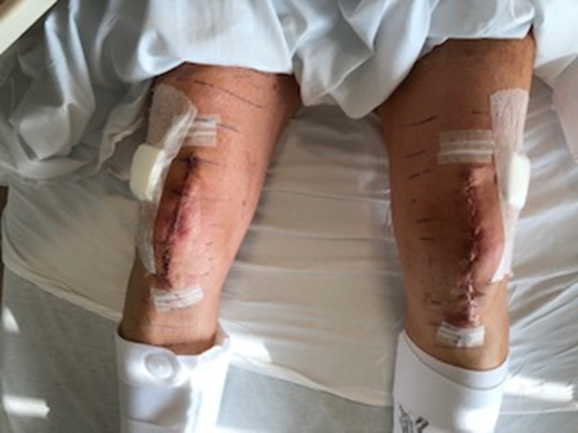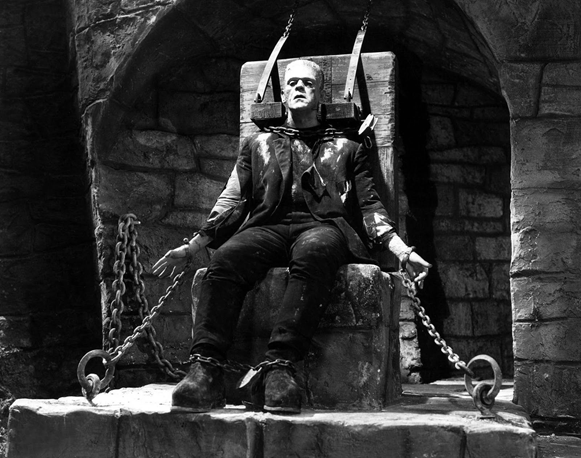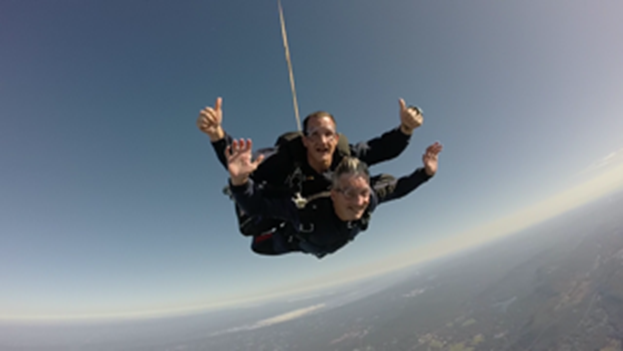Hey Friends and Former Co-Workers:
October 1, 2020, marks two years to the day that I underwent a double total knee replacement operation at the Hospital for Special Surgery (HSS) in New York City.
Wayne Cotter thought a short story chronicling my experience might be helpful to those who are considering this major operation.
Perhaps such a story might also be amusing to our former Insurance Department colleagues who also underwent knee replacement surgery. Sal Curiale and Augie D’Aureli, get ready for a flashback!
Enjoy, Mark
***************************************
Double Knee (Replacement) Deep In The Big Muddy
and The Old Doc Says To Push On
by Mark Gardner
It was a tiny green light that was keeping me awake. At 3:46 a.m., it was shining directly into my eyes. Like Kryptonite, that bright green light was making me weak and sapping my strength. It was only about half the width of a dime and emanating from a medical monitor. Fifteen feet away from me, unaware of his own Green Lantern light, my roommate was sleeping soundly in his hospital bed.
I was in Burke Rehabilitation Hospital in White Plains. It had been two weeks since I had been in HSS in NYC for five days recovering from my double knee replacement operation. Thanks to an unusual medical complication, I would be staying in Burke for yet another week. During that time, I was either totally bed-ridden or being pushed around in a wheelchair. And little did I know that after my discharge from Burke, a surprise Dark Ages medical procedure and another five months of out-patient physical therapy would follow.
Weeks earlier, the operation had gone well. No post-op infection. The scars on my knees, while red and angry, looked normal. Like this:

The care at HSS was very attentive and beyond what I had expected. It is THE place to go for any bone operation. In my first 72 hours post-op, everything looked promising. I prematurely congratulated myself on my shrewd decision-making. However, like anyone buckling into a high-stakes, surgical, roller coaster ride, I could never have fully prepared myself for the whole ride. There were to be so many extreme highs and lows during the ride.
First, there was the operation itself. I had been scheduled to go in at 2:30 p.m. Of course I had wanted the very first morning appointment. But when you sign up with the chairman of the “Knee Department” at HSS, you take whatever time you can get, unless you want to wait another month or more. So like the flights at LaGuardia and JFK, if you don’t get on that first one, you’ll invariably be delayed as the many operations of the day back up. The operation finally started around 5:30 p.m.
All I can remember was that right after the anesthesiologist gave me a shot of “happy juice”, as he called it, I had to slide onto the operation table. It was hard as a sheet of plywood. Then, as if it was just ten minutes later, I awoke. The operation actually took about four hours. I was surprised to wake up to see the doctor, and my wife and daughter, seemingly one hundred yards away, but yet at the foot of my bed. I was surfing a blended ecstasy of a spinal block, a steady flow of morphine and some other narcotics. As I chortled with unbridled joy about how GREAT I felt, my wife, daughter and the doctor laughed. The unimaginable pain was yet to come.
Post-Op
I spent the next five days at HSS in a shared hospital room. Did you know that there is absolutely no privacy in a shared hospital room? All that separates you from your new best friend is five feet of space and a thin curtain. The experience is very up close and very personal. It’s humbling. While you wind your way in and out of sleep, you talk about everything with your new best friend. You talk about your operation, your kids, the state your marriage, your past, and the future. It’s like you’re on a continuous truth serum drip. Inhibitions vanish.
My first roommate, Joe, was a guy nearly my age who underwent a replacement . . . of his first hip replacement.
I listened closely when a doctor told Joe that unless he changed his lifestyle, he would become diabetic. Eventually, Joe would need to have a SECOND replacement of his original hip replacement Later, in my continuing narcotic haze, I asked Joe whether he really served a half gallon of Pepsi every night at the family dinner table.
As was Roommate Joe, I was unable to get out of bed. At all. I laid in a hospital bed 24/7. That was both a completely helpless feeling, and one which could well be a window into living until a very old age. Unable to get out of bed, one has no choice but to urinate - - constantly - - into a plastic tankard. Fortunately, going “Number 2” and facing the indignity of a bedpan is less of a concern. The amount of opiate pain killers ingested daily creates a business opportunity for which Ex Lax would kill.
My second roommate had a single knee replacement, even though he needed both knees replaced. In six weeks, he would be returning to HSS to re-enact the entire experience. Unwisely, I secretly smirked at his lack of courage.
On Day #3 in HSS, while my Foley catheter was being removed from You-Know-Where, (surprisingly, not painful), I was told that I would need to urinate within four hours. If not, they would need to re-insert the catheter - - without any form of anesthesia. I became highly motivated! You know I drank enough cranberry juice to achieve the mission.
On Day #4, while humming along happily on a new powerful narcotic called Dilaudin, I calmly informed one of the nurses that because I was completely unable to get out of my bed, much less walk, if there was a fire in the ward, I would probably die in that bed. She was not amused by that comment.
On Day #5, I was strapped into a chair just like the Frankenstein monster in “Bride of Frankenstein” (see photo). Immobilized and sitting upright, I was wheeled to the front door of HSS, loaded up a ramp into an ambulette and driven about 45 minutes to Burke Hospital in White Plains.

Three Weeks at Burke
My three weeks at Burke were - - okay, I won’t sugar coat it for you - - excruciating. One of the most desirable, somewhat famous, services offered by Burke is its special three-times-a-day physical therapy. Six days a week, three times a day, they lift you out of bed, sit you in a wheelchair, and wheel you down to the basement. Of course the “therapy” has to be in the basement. Think for a minute: Where did the killers in the movies “In Cold Blood” and “The Amityville Horror” do their dirty work?
In the basement, along with about forty other patients, you are assigned to a physical therapist who puts you through an hour of painful exercises. Wait: did I mention that the exercises were painful? So painful that the nurses in Burke insist that you take Dilaudin one hour before you descend into the Nine Circles of Dante’s Inferno.
While I underwent “three-a-days” at Burke, like some aspiring high school football player in July pre-season training, time often stopped. The hands on the clock never moved. Once, I looked at my wall clock and it was 1:30 p.m. I looked again after a nap and it was:

Most knee replacement patients stay in Burke and undergo the “three-a-days” for three or four days before recovering the 90 - 120 degrees of knee bending required to be discharged. Me? Like John Belushi used to yell, BUT NOOOOOO. After about two weeks in Burke, I was informed that I was a member of an unfortunate club of which no one wants to be a member.
The club is called “The Unlucky Five Percent.” Remember the “1%” castigated years ago by the Occupy Wall Street protesters? The 1% were the wealthy elites who rested easy. “The Unlucky Five Percent” is exactly the opposite.
For some reason unknown to modern science, approximately five percent of knee replacement patients build up excessive scar tissue and are unable to bend their knee(s) in a normal time frame. My second roommate at Burke was discharged within four days. Me, not so fast. I was at Burke for a total of three weeks, and spent most of my days like this:

At Burke, I had three roommates. It was quite an ethnic potpourri. The first was a 40-year old Black man who had Type 1 diabetes. His right leg had to be amputated above the knee. Terrible. But his attitude was so positive and he seemed to shake it off like it was a minor sports injury. The second roommate was a flamboyantly gay 65-year-old man whose husband came to visit every night. One night, when three of my friends came to visit, the two patients, the husband, and the group were laughing so loudly that nurses had to come down the hall to quiet the barroom-like room.
The third roommate was the outlier. He was an 80-something old man of German descent who was suffering from unexplained pain in his feet. Although I knew he was too young, Roommate #3 looked like a wizened guard of a Nazi death camp. I guess the doctors didn’t know what else to do with him, so they sent him to Burke for a week. He watched Fox News 24/7 at the highest decibel level possible. It was deafening.
At the time, Fox News was closely monitoring the movement of a caravan of Central American migrants towards the U.S. border. Whenever Fox covered the story, and that was numerous times a day, he said the same thing each time: “Start shooting.” No, I’m not making this up; I told you it was quite an intimate setting.
While at Burke, I progressed from a wheelchair, to two canes, to one cane. Finally, after three weeks at Burke, I was sent home. But even in my own house, I was still very unsteady on my feet. Balance was a big problem. Consequently, about a week after my discharge from Burke, to break up the accumulating scar tissue in my knees, I endured a special out-patient procedure called, “Manipulation Under Anesthesia.” Back to HSS I went. My doctor used the same primitive method probably employed during the medieval ages - - if knee replacements could have been performed back then.
Here’s how it works: while you lie on your back on a bed, a doctor grabs both of your ankles and snaps your legs back and forth to break up the scar tissue. Light sedation was required for this three-to-five minute procedure, although I was told that patients were awake for this as recently as a few years ago. Huh?
Prior to wrestling my legs into bent submission, my doctor had been sort of AWOL. After I was told at Burke that I was evidently building up restrictive scar tissue, I tried to contact my doctor. But I was informed by his nurse that he couldn’t be reached, “for several weeks”. What? Several weeks? Isn’t another doctor supposed to stand in?
Where did he go? An African safari? A cruise to Patagonia? Doctors Without Borders?
The Manipulation
So it was with some amount of annoyance that after a few weeks, I was finally able to schedule an appointment with him to discuss the upcoming Manipulation Under Anesthesia. To be honest, I was prepared to unload on him my frustrations of walking around unsteadily, with the constant fear of being accidentally jostled and falling. Like I said earlier, it’s a window into living until a very old age.
Amazingly, he had a valid reason for his absence, but it was like the surprise movie ending you never saw coming. In that windowless examining room, where I asked him pointedly where he had been while I was doing three-a-days at Burke for three weeks, his answer hung in the air like a ghost. He said sheepishly, “I had one of my knees done”. Of course I could not resist a targeted barb. I asked him to whom he went for his operation. After he replied, I said: “Great! I guess I’ll go to him next time”. We both laughed.
The Manipulation was somewhat successful insofar as I was able to bend my knees a few more degrees. But I also had to embark on a two-to-three-time-a-week regimen of physical therapy at Burke’s satellite branch in Armonk. That lasted about another four months. Fortunately, that physical therapy was neither held in a basement nor of a pain level experienced at Burke White Plains. Sometime in March 2019, I was finally able to graduate to a regular health club, where I did the exercises on my own.
So maybe my story sounds terrible and alarming to anyone who may be facing a double knee operation. Yes, it was long and difficult. One lesson I learned is that even when you think everything will go smoothly after an operation, a slider can appear on the outside corner that brings you to your knees (no pun intended) as the umpire yells: “Strike Three!”
But 95% of people are not members of The Unlucky Five Percent. Very few people will build up the scar tissue that sends one back to the doctor. And in the end, it was so worth it. Before the operation, I was unable to walk half a mile and despondent when I approached a tall staircase. I couldn’t stand in one place for more than two minutes. Exactly one year after the operation, I looked like this:

So I guess my final piece of advice is: consider all your options, check out HSS, and feel free to call or email me if you have any questions on my experience.
